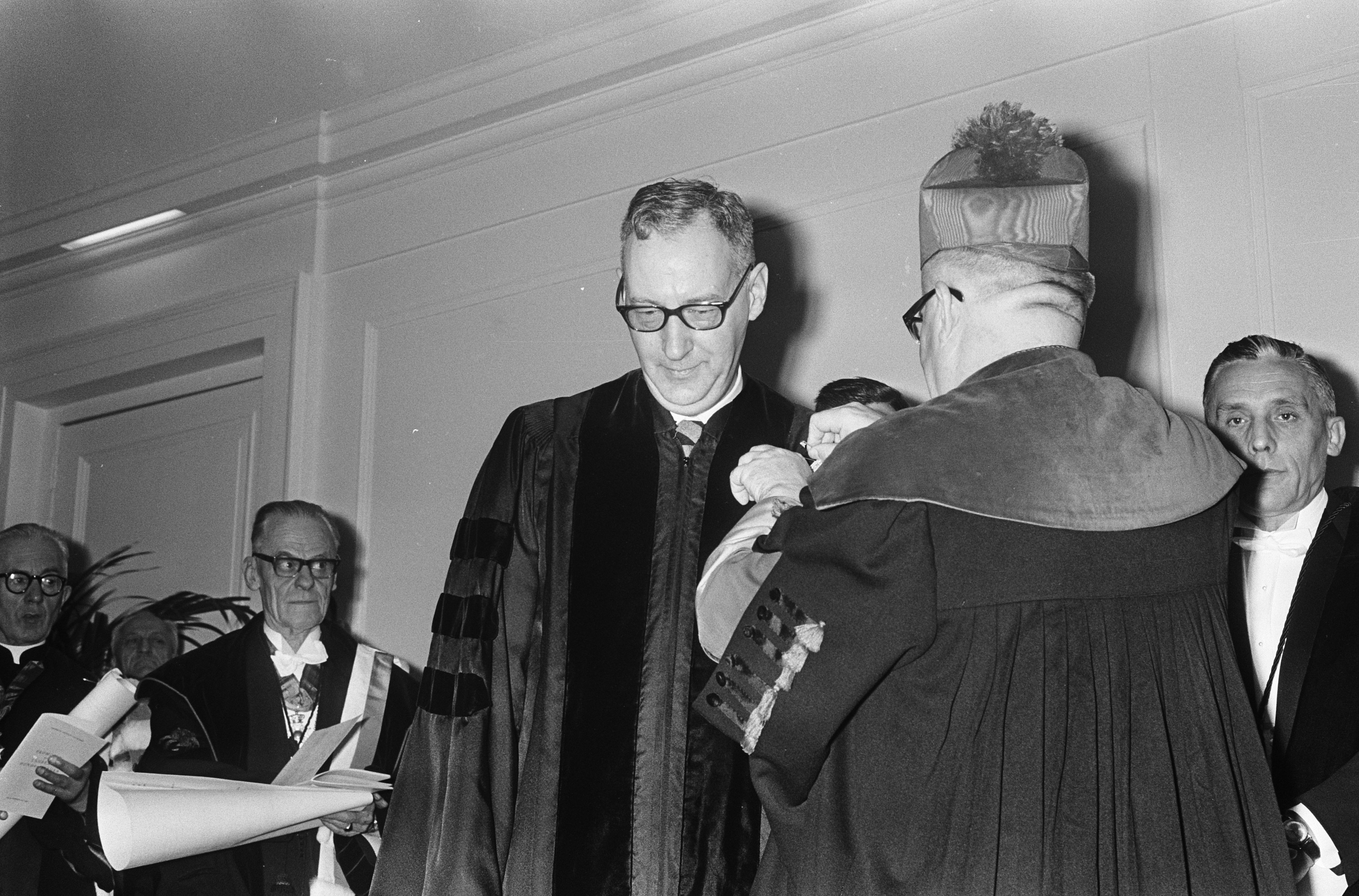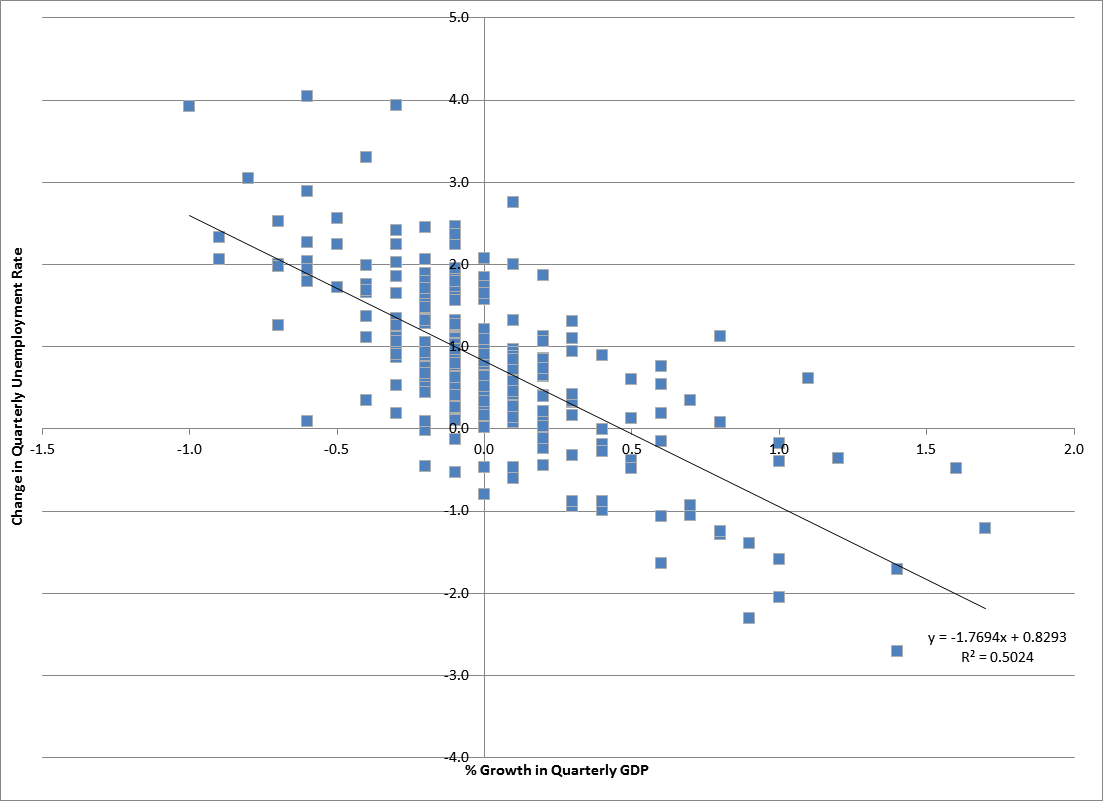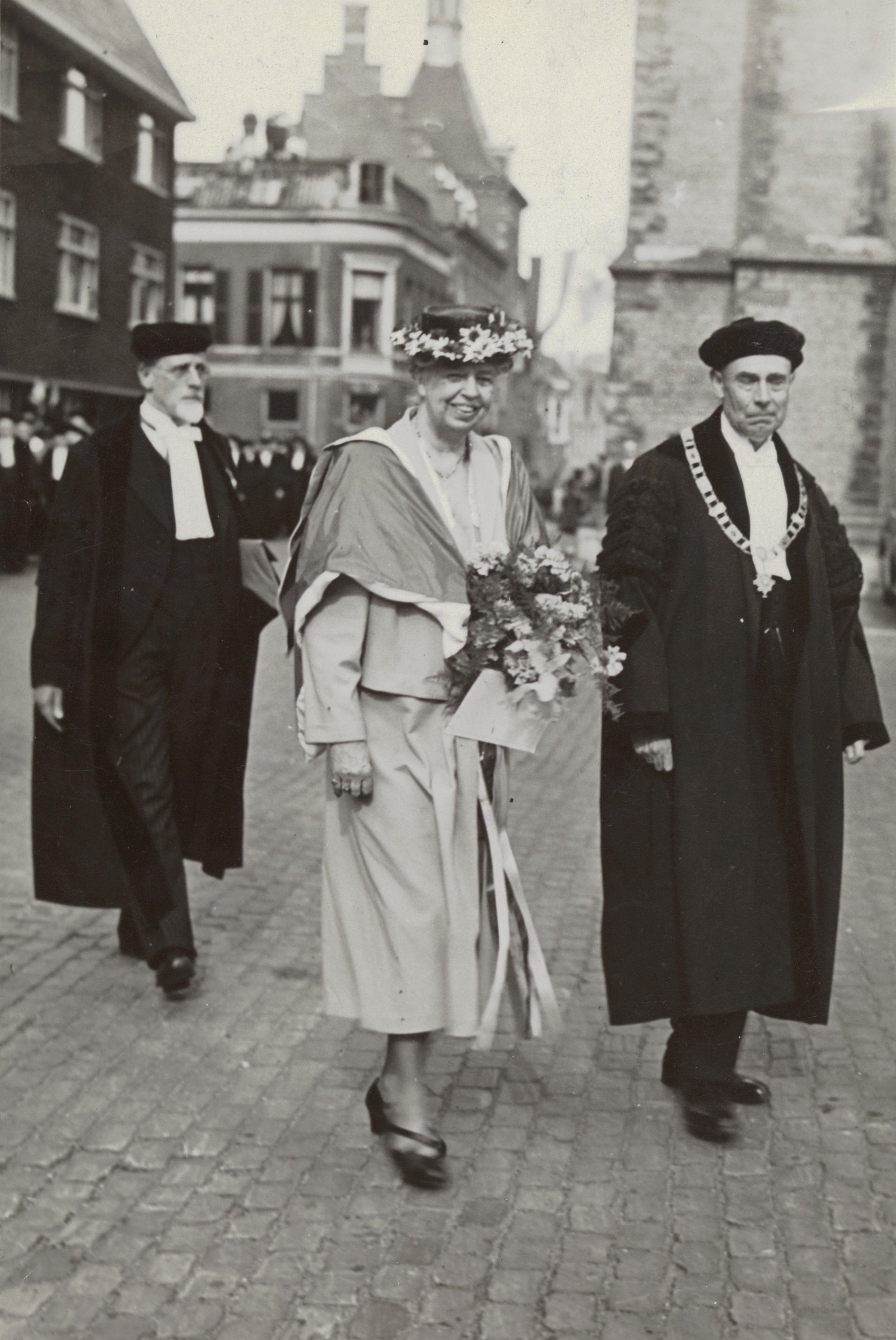|
Tjalling Koopmans
Tjalling Charles Koopmans (August 28, 1910 – February 26, 1985) was a Dutch-American mathematician and economist. He was the joint winner with Leonid Kantorovich of the 1975 Nobel Memorial Prize in Economic Sciences for his work on the theory of the optimum allocation of resources. Koopmans showed that on the basis of certain efficiency criteria, it is possible to make important deductions concerning optimum price systems. Biography Koopmans was born in 's-Graveland, Netherlands. He began his university education at the Utrecht University at seventeen, specializing in mathematics. Three years later, in 1930, he switched to theoretical physics. In 1933, he met Jan Tinbergen, the winner of the 1969 Nobel Memorial Prize in Economics and moved to Amsterdam to study mathematical economics under him. In addition to mathematical economics, Koopmans extended his explorations to econometrics and statistics. In 1936, he graduated from Leiden University with a PhD, under the directi ... [...More Info...] [...Related Items...] OR: [Wikipedia] [Google] [Baidu] |
's-Graveland
s-Graveland () is a village in the Dutch province of North Holland. It is a part of the municipality of Wijdemeren, and lies about 4 km northwest of Hilversum. The former municipality of 's-Graveland merged with Loosdrecht and Nederhorst den Berg on 1 January 2002 to form the new municipality Wijdemeren. The village was first mentioned in 1634 as "de akkers in 's Graevenlandt" and means "the land of Count of Holland" ( Albrecht van Beieren) and served as a hunting ground. This area was cultivated from 1625; nine years later the resulting polder was parceled out to six people. A popular location for the country estates of Amsterdam burghers, the village contains several historic houses dating mostly to the 17th century. Early history Transport by ship, initially via the Zuiderzee and the Utrechtse Vecht, was often preferred over carriage. The road to Weesp was improved in 1627. The 's-Gravelandseweg was not paved. The 's-Gravelandsevaart, dug out in 1634, used to be a major c ... [...More Info...] [...Related Items...] OR: [Wikipedia] [Google] [Baidu] |
Koopmans' Theorem
Koopmans' theorem states that in closed-shell Hartree–Fock theory (HF), the first ionization energy of a molecular system is equal to the negative of the orbital energy of the highest occupied molecular orbital (HOMO). This theorem is named after Tjalling Koopmans, who published this result in 1934 for atoms. Koopmans' theorem is exact in the context of restricted Hartree–Fock theory if it is assumed that the orbitals of the ion are identical to those of the neutral molecule (the ''frozen orbital'' approximation). Ionization energies calculated this way are in qualitative agreement with experiment – the first ionization energy of small molecules is often calculated with an error of less than two electron volts. Therefore, the validity of Koopmans' theorem is intimately tied to the accuracy of the underlying Hartree–Fock wavefunction. The two main sources of error are orbital relaxation, which refers to the changes in the Fock operator and Hartree–Fock orbit ... [...More Info...] [...Related Items...] OR: [Wikipedia] [Google] [Baidu] |
League Of Nations
The League of Nations (LN or LoN; , SdN) was the first worldwide intergovernmental organisation whose principal mission was to maintain world peace. It was founded on 10 January 1920 by the Paris Peace Conference (1919–1920), Paris Peace Conference that ended the World War I, First World War. The main organisation ceased operations on 18 April 1946 when many of its components were relocated into the new United Nations (UN) which was created in the aftermath of the World War II, Second World War. As the template for modern global governance, the League profoundly shaped the modern world. The League's primary goals were stated in its Covenant of the League of Nations, eponymous Covenant. They included preventing wars through collective security and Arms control, disarmament and settling international disputes through negotiation and arbitration. Its other concerns included labour conditions, just treatment of native inhabitants, Human trafficking, human and Illegal drug tra ... [...More Info...] [...Related Items...] OR: [Wikipedia] [Google] [Baidu] |
Economic And Financial Organization Of The League Of Nations
The Economic and Financial Organization (EFO, ) was the largest of the technical arms of the League of Nations, and the world's first international organization dedicated to promoting economic and monetary co-operation. It took shape in the early 1920s and was in activity until the creation of the United Nations in 1945. It has been described as having had seminal influence on postwar economic institutions, notably the International Monetary Fund (IMF). Background The establishment of the EFO took place in the aftermath of unprecedented transnational cooperation initiatives among allied powers during World War I, which were also pioneering experiments in planned economy imposed by the circumstances. These included the Wheat Executive established in late 1916, and the Allied Maritime Transport Council established in late 1917. They had brought together enterprising civil servants such as Italy's Bernardo Attolico, France's Jean Monnet, and Britain's Arthur Salter, who would pl ... [...More Info...] [...Related Items...] OR: [Wikipedia] [Google] [Baidu] |
Hendrik Kramers
Hendrik Anthony "Hans" Kramers (17 December 1894 – 24 April 1952) was a Dutch physicist who worked with Niels Bohr to understand how electromagnetic waves interact with matter and made important contributions to quantum mechanics and statistical physics. Background and education Hans Kramers was born on 17 December 1894 in Rotterdam. the son of Hendrik Kramers, a physician, and Jeanne Susanne Breukelman. In 1912 Hans finished secondary education ( HBS) in Rotterdam, and studied mathematics and physics at the University of Leiden, where he obtained a master's degree in 1916. Kramers wanted to obtain foreign experience during his doctoral research, but his first choice of supervisor, Max Born in Göttingen, was not reachable because of the First World War. Because Denmark was neutral in this war, as was the Netherlands, he travelled (by ship, overland was impossible) to Copenhagen, where he visited unannounced the then still relatively unknown Niels Bohr. Bohr took him on as a Ph ... [...More Info...] [...Related Items...] OR: [Wikipedia] [Google] [Baidu] |
Leiden University
Leiden University (abbreviated as ''LEI''; ) is a Public university, public research university in Leiden, Netherlands. Established in 1575 by William the Silent, William, Prince of Orange as a Protestantism, Protestant institution, it holds the distinction of being the oldest university in the Netherlands of today. During the Dutch Golden Age scholars from around Europe were attracted to the Dutch Republic for its climate of intellectual tolerance. Individuals such as René Descartes, Rembrandt, Christiaan Huygens, Hugo Grotius, Benedictus Spinoza, and later Baron d'Holbach were active in Leiden and environs. The university has seven academic faculties and over fifty subject departments, housing more than forty national and international research institutes. Its historical primary campus consists of several buildings spread over Leiden, while a second campus located in The Hague houses a liberal arts college (Leiden University College The Hague) and several of its faculties. It i ... [...More Info...] [...Related Items...] OR: [Wikipedia] [Google] [Baidu] |
Statistics
Statistics (from German language, German: ', "description of a State (polity), state, a country") is the discipline that concerns the collection, organization, analysis, interpretation, and presentation of data. In applying statistics to a scientific, industrial, or social problem, it is conventional to begin with a statistical population or a statistical model to be studied. Populations can be diverse groups of people or objects such as "all people living in a country" or "every atom composing a crystal". Statistics deals with every aspect of data, including the planning of data collection in terms of the design of statistical survey, surveys and experimental design, experiments. When census data (comprising every member of the target population) cannot be collected, statisticians collect data by developing specific experiment designs and survey sample (statistics), samples. Representative sampling assures that inferences and conclusions can reasonably extend from the sample ... [...More Info...] [...Related Items...] OR: [Wikipedia] [Google] [Baidu] |
Econometrics
Econometrics is an application of statistical methods to economic data in order to give empirical content to economic relationships. M. Hashem Pesaran (1987). "Econometrics", '' The New Palgrave: A Dictionary of Economics'', v. 2, p. 8 p. 8–22 Reprinted in J. Eatwell ''et al.'', eds. (1990). ''Econometrics: The New Palgrave''p. 1 p. 1–34Abstract ( 2008 revision by J. Geweke, J. Horowitz, and H. P. Pesaran). More precisely, it is "the quantitative analysis of actual economic phenomena based on the concurrent development of theory and observation, related by appropriate methods of inference." An introductory economics textbook describes econometrics as allowing economists "to sift through mountains of data to extract simple relationships." Jan Tinbergen is one of the two founding fathers of econometrics. The other, Ragnar Frisch, also coined the term in the sense in which it is used today. A basic tool for econometrics is the multiple linear regression model. ''Econome ... [...More Info...] [...Related Items...] OR: [Wikipedia] [Google] [Baidu] |
Mathematical Economics
Mathematical economics is the application of Mathematics, mathematical methods to represent theories and analyze problems in economics. Often, these Applied mathematics#Economics, applied methods are beyond simple geometry, and may include differential and integral calculus, Recurrence relation, difference and differential equations, Matrix (mathematics), matrix algebra, mathematical programming, or other Computational economics, computational methods.TOC. Proponents of this approach claim that it allows the formulation of theoretical relationships with rigor, generality, and simplicity. Mathematics allows economists to form meaningful, testable propositions about wide-ranging and complex subjects which could less easily be expressed informally. Further, the language of mathematics allows economists to make specific, positiv ... [...More Info...] [...Related Items...] OR: [Wikipedia] [Google] [Baidu] |
Amsterdam
Amsterdam ( , ; ; ) is the capital of the Netherlands, capital and Municipalities of the Netherlands, largest city of the Kingdom of the Netherlands. It has a population of 933,680 in June 2024 within the city proper, 1,457,018 in the City Region of Amsterdam, urban area and 2,480,394 in the Amsterdam metropolitan area, metropolitan area. Located in the Provinces of the Netherlands, Dutch province of North Holland, Amsterdam is colloquially referred to as the "Venice of the North", for its canals of Amsterdam, large number of canals, now a World Heritage Site, UNESCO World Heritage Site. Amsterdam was founded at the mouth of the Amstel River, which was dammed to control flooding. Originally a small fishing village in the 12th century, Amsterdam became a major world port during the Dutch Golden Age of the 17th century, when the Netherlands was an economic powerhouse. Amsterdam was the leading centre for finance and trade, as well as a hub of secular art production. In the 19th ... [...More Info...] [...Related Items...] OR: [Wikipedia] [Google] [Baidu] |
Utrecht University
Utrecht University (UU; , formerly ''Rijksuniversiteit Utrecht'') is a public university, public research university in Utrecht, Netherlands. Established , it is one of the oldest universities in the Netherlands. In 2023, it had an enrollment of 39,769 students, and employed 8,929 faculty members and staff. More than 400 PhD degrees were awarded and 7,765 scientific articles were published. The university's 2023 budget was €2.8 billion, consisting of €1.157 billion for the university (income from work commissioned by third parties is 319 million euros) and €1.643 billion for the University Medical Center Utrecht. The university's interdisciplinary research targets life sciences, pathways to sustainability, dynamics of youth, and institutions for open societies. Utrecht University is led by the University Board, consisting of Wilco Hazeleger (Rector Magnificus), Anton Pijpers (chair), Margot van der Starre (Vice Chair) and Niels Vreeswijk (Student Assessor). Close ties are h ... [...More Info...] [...Related Items...] OR: [Wikipedia] [Google] [Baidu] |







